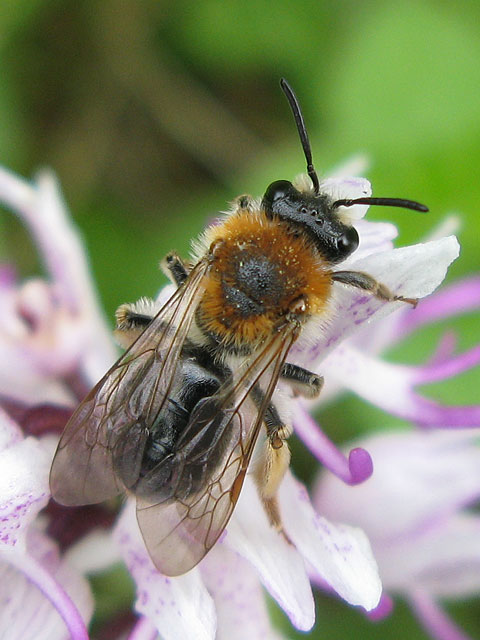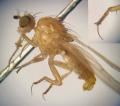Diptera.info :: Identification queries :: Other insects, spiders, etc.
|
Bee on Orchis simia
|
|
| ChrisR |
Posted on 23-05-2008 13:47
|
|
Super Administrator Location: Reading, England Posts: 7706 Joined: 12.07.04 |
Can anyone suggest a name for this nice looking bee? It was seen on an Orchis simia in southern England, 20-May-2008 
ChrisR attached the following image:  [62.53Kb] Edited by ChrisR on 23-05-2008 13:47 |
| Jan Willem |
Posted on 23-05-2008 14:46
|
|
Member Location: Waalwijk, The Netherlands Posts: 2160 Joined: 24.07.04 |
Hi Chris, According to a friend of mine who happens to be a hymenopterist, this is a species of the genus Andrena, possibly A. haemorrhoa. Jan Willem van Zuijlen |
|
|
|
| ChrisR |
Posted on 24-05-2008 01:24
|
|
Super Administrator Location: Reading, England Posts: 7706 Joined: 12.07.04 |
Thanks Jan Willem - much appreciated. We like to try to identify anything that looks like a potential pollinator of Orchis simia  |
| Christian Schmid-Egger |
Posted on 24-05-2008 08:48
|
|
Member Location: Germany, Berlin Posts: 233 Joined: 05.08.05 |
I agree with the diagnosis, but the typical and specialised orchid-bee interaction happens between bee males and the plant (pheromone attraction), but on the photo is a female. Sometimes, Andrena males are found with a large pollen restore organ from an Orchid in the face. The most known Orchid pollinator is a Scoliidae, the male of Dasyscolia ciliata, in the Mediterranean area. I am not a specialist in this field, but a 'normal' pollination between female bee and Orchis is also possbible. A. haemorrohoa is polylectic, it takes pollen from various plants. Regards, Christian |
| ChrisR |
Posted on 24-05-2008 09:50
|
|
Super Administrator Location: Reading, England Posts: 7706 Joined: 12.07.04 |
Thanks for the comments Christian - very interesting. I have been trying to collect information about possible pollinators of Orchis simia on this specific site because we have plenty of natural pollination, whereas a similar site in Kent doesn't seem to have. The orchid is extremely rare in England and this site (http://hartslock....) is only 1 of 3 sites - the others being of more recent origins so we hypothesise that the natural pollinator (whatever it might be) doesn't occur in Kent but does occur here on our site 
Edited by ChrisR on 24-05-2008 09:51 |
| Sundew |
Posted on 24-05-2008 10:33
|
|
Member Location: Berlin and Baden-Württemberg, Germany Posts: 3938 Joined: 28.07.07 |
I must correct Christian's statement as to "typical" orchid pollination - in Europe an attraction of males by pheromones occurs in the genus Ophrys only; in Australia there are about 9 genera that are pollinated by sexual deception, and also in South America there are a few. So successfully imitating the female of a pollinator is a very interesting but rare phenomenon in the giant orchid family. Orchis flowers are fragrant, and many are deceivers, as their spurs are dry and no reward is offered. Concerning O. simia, the literature is controversial. Knuth (1898) mentions a nectar production, Ziegenspeck (1936) denies the presence of nectar. The latter might be right. Try to test it with a narrow strip of saccharose test paper put into the spur! - In any case, female bees visit these flowers in their search for nectar, attracted by the scent. Males could also occur for a supposed drink, but not to mate. If you are interested in more information about orchid pollination, do not hesitate to ask me. Cordially, Sundew Edited by Sundew on 24-05-2008 10:34 |
|
|
|
| Jump to Forum: |













